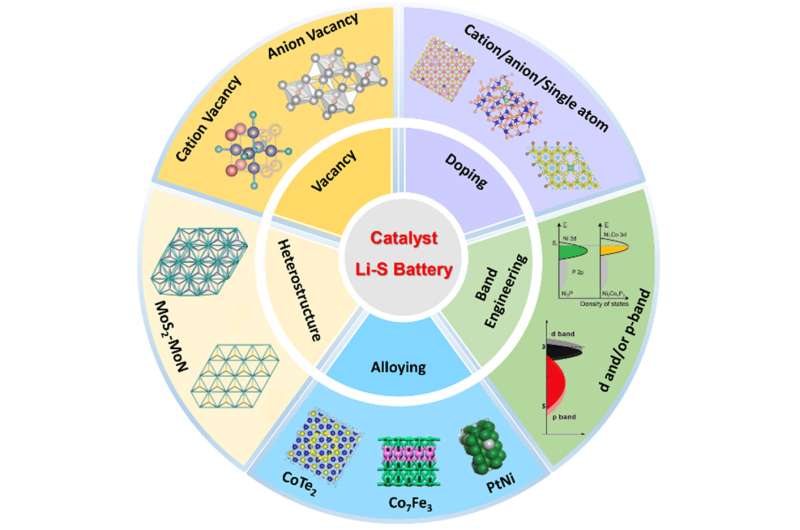
The notorious polysulfide shuttle severely impedes the practical application of Li-S batteries. Utilizing various electrocatalysts to improve the polysulfide redox kinetics has emerged as a promising strategy to address the shuttle effect.
The electronic structure of the electrocatalysts plays a decisive role in determining the catalytic activity to facilitate the polysulfide conversion. Therefore, reasonably modulating the electronic structure of electrocatalysts is of paramount significance for improving the electrochemical performance of Li-S batteries. However, previous reviews focus on the classification of catalytic materials in term of their physical and chemical properties, which ignores the relationship between electronic structure and catalytic activity.
Recently, a research team led by Profs. Liang Zhang and Yanguang Li from Soochow University in China systematically summarized the strategies for optimizing the electronic structure of electrocatalysts for Li-S batteries and established the relationship between electronic structure and catalytic activity. Future perspectives and challenges are also proposed for designing high-efficient electrocatalysts to construct high-energy-density and long-lifetime Li-S batteries. The review was published in Chinese Journal of Catalysis.
A comprehensive overview of the fascinating strategies to tailor the electronic structure of electrocatalysts for Li-S batteries is presented, including vacancy engineering, heteroatom doping, single atom doping, band regulation, alloying, and heterostructure engineering.
Vacancy engineering aims at creating more active sites and tune the surface charge-transfer property. Meanwhile, vacancies can significantly promote the electrocatalytic activity by optimizing the surface-adsorption ability for reaction intermediates, which derives from the abundance of localized electrons around vacancies. Additionally, the vacancies can tailor the surface hydrophilic property for a better electrolyte contact.
In summary, designing sulfur host materials with high catalytic activity has provided a new direction towards high-performance Li-S batteries. The high-efficiency electrocatalysts with high activity and special functions can be obtained through the coordination of various electronic structure regulation strategies, which can further improve the electrochemical performance of Li-S batteries and also enlighten other energy-related processes based on multi-electron reactions.
Pan Zeng et al, Recent progress in electronic modulation of electrocatalysts for high-efficient polysulfide conversion of Li-S batteries, Chinese Journal of Catalysis (2022). DOI: 10.1016/S1872-2067(21)63984-0
Citation:
High-efficiency electrocatalysts could be realized through electronic modulation for advanced lithium-sulfur batteries (2022, November 29)
retrieved 29 November 2022
from https://techxplore.com/news/2022-11-high-efficiency-electrocatalysts-electronic-modulation-advanced.html
This document is subject to copyright. Apart from any fair dealing for the purpose of private study or research, no
part may be reproduced without the written permission. The content is provided for information purposes only.
Stay connected with us on social media platform for instant update click here to join our Twitter, & Facebook
We are now on Telegram. Click here to join our channel (@TechiUpdate) and stay updated with the latest Technology headlines.
For all the latest Technology News Click Here
For the latest news and updates, follow us on Google News.
